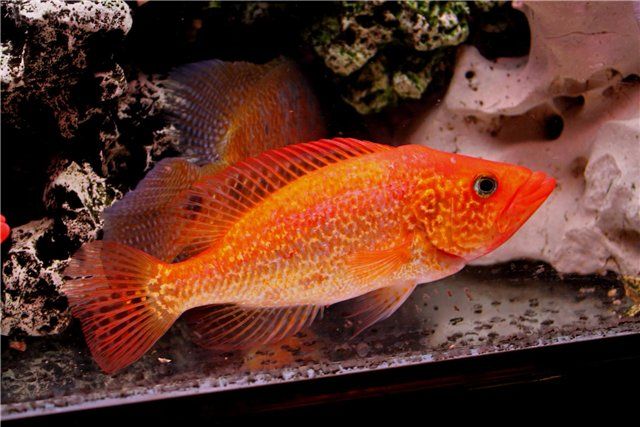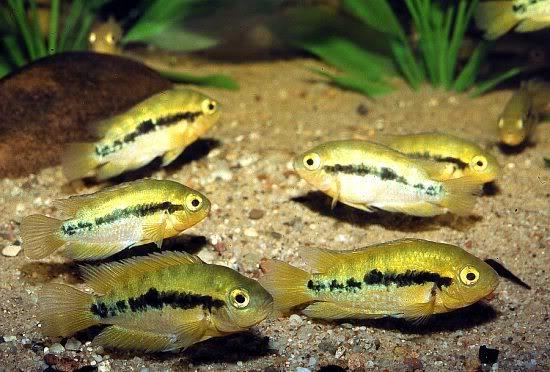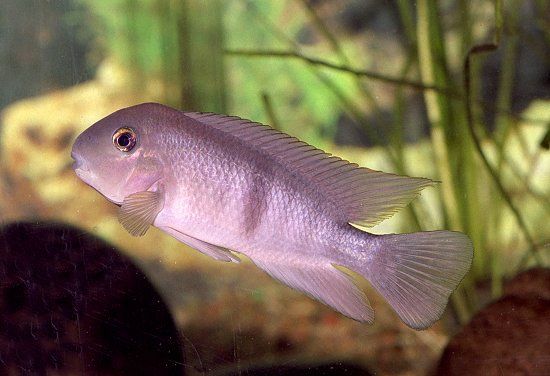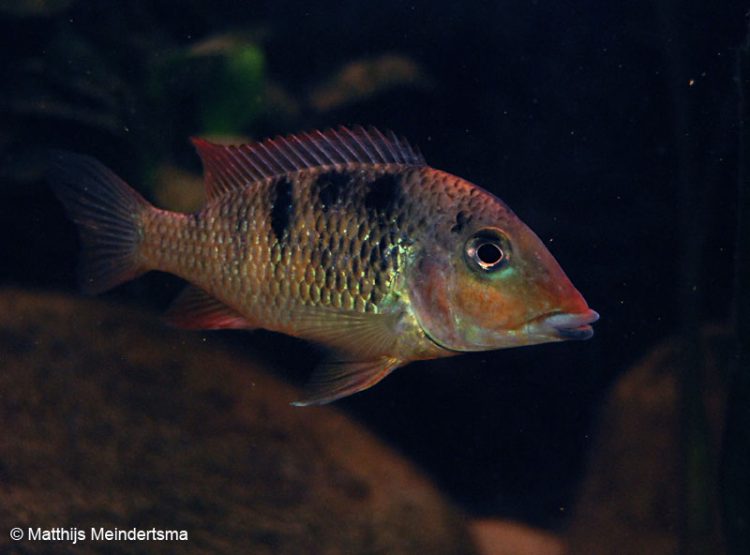What’s in a name? As a fishkeeper, you’ve seen it time after time: A bunch of guys at a society meeting, arguing over a white plastic pail…
“It’s Heros,” says one.
“I believe Conkel calls it Nandopsis,” replies another.
“They’re working on the whole family…I think they put that one in Parapetenia,” chimes a third.
After a while the breeder’s award honcho steps in, and authoritatively cuts through the clutter with, “we’ll just list it as Cichlasoma.”
Finally, you know what they’re talking about: Central American cichlids. The bucket brigaders all shrug their shoulders and acquiesce to the tried and true Cichlasoma. Big, ugly, greyish, conspiratorial monsters that go about their plant eating and gravel moving with a deliberate, deranged tenacity…or, highly evolved creatures with tremendous parental tendencies of which the finest specimens always seem to draw the most attention at fish shows. Which is it? Will the real Cichlasoma please step forward?
Actually, all of it is true, except the Cichlasoma part. Central American cichlids tend to be greyish, but they also dress in a rainbow of colorful spangles. They often pester and kill their own kind, but they are also fiercely devoted parents. They are a little of everything, except the one thing everybody was certain about: they aren’t “cichlasoma.”
Indeed, they are “cichlasomines,” but not of the genus Cichlasoma. After what was probably very dreary research through some moldy volumes, it has been determined that Cichlasoma was originally used to describe some of the South American fishes popularly known as Acaras. (But not all Acaras. The best known example is probably the “port-hole cichlid,” or Cichlasoma taenia,not to be confused with the more colorful “port cichlid.”) Thus the Central Americans were cast adrift, with no popular name to anchor to.
The scientists, for their part, are redesigning the whole spectrum of Central American names. The problem is that just when they think they have everything sewed up in neat little scientific packages, some hobbyist trudges through a swamp in one of the banana republics and pulls out a new ugly grey dog that doesn’t quite fit. Eventually, all the notes will match and we’ll have a lengthy list of highly accurate names.
In the meantime, the following descriptions are an easy-to-remember and occasionally accurate way to classify the Central Americans. Perfect for the bucket brigade, and usually garners a grunt of approval from the scientific types. Better still, you can easily memorize these classifications with the help of an acronym. (Be forewarned that the acronym memorization method is unlikely to garner any approval whatsoever from the scientific types). Here’s how it works:
The Acronyms: NATHAT and PHANG
NATHAT represents the six types often mislabeled “cichlasoma.” PHANG represents the oddballs, the cichlids that defy being lumped into the main six. Again, these six are currently being reclassified into a host of more exacting genera, but if you can learn them at this simplified level you are on your way to a better understanding of Central American cichlids!
The order is approximately by size, largest to smallest, with the exception of the five oddballs that follow. The acronym NATHAT stands for Nandopsis, Amphilophus, Theraps, Herichthys, Archocentrus, Thorichthys. The size ranking is generally that the largest Nandopsis is bigger than the largest Amphilophus, and so on down the line. There are of course a few Herichthys larger than many Nandopsis, but for the sake of sanity we’ll do it the easy way and stick with NATHAT.
Be warned that the Latin is not exact — fenestratus, fenestratum? Sorry, I don’t speak Italian.
Nandopsis
If you know what a “managuense” or jaguar cichlid looks like, you’ll have a pretty good concept of what the Nandopsis are all about. These tend to be submarine-shaped predators, with a concave forehead, upturned mouth, and highly proctractile jaw. Known as the guapotes, these fish are built to pursue smaller fish and eat them. Dovii and umbriferum get size honors, while salvinii is regarded as the smallest. If you think only in terms of their silhouette, all of the aforementioned fish are essentially the same. Other well-known Nandopsis include the motaguense, loisellei, grammodes, minckleyi, and the preeminent nasty grey dog, the “red terror” or Nandopsis urophthalmus. According to some the prettier red terror, N. festae, is also in this group.
Nandopsis species have the widest territorial range of the Central Americans: North and west through Mexico, south to where the festaes and umbies range into Colombia, and east to the Dominican Republic where the haitiensis is found.
Amphilophus
Picture the shape of a red devil, and you’ve got the Amphilophus. If you’ve done your homework, you might be wondering which red devil, labiatum or citrinellus? Either one; both are Amphilophus. Some tend to be slender, with long snouts like A. labiatus; others tend to be taller, with pointy snouts like A. citrinellus. (citrinellus – or is it citrinellum – is also known as the midas cichlid). All tend to have concave foreheads, and most display seven wide vertical bars when young. Many Amphilophus make their living by sucking crustaceans and other chum out of gravel and crevices in lakes, so you can frequently identify this genera as the fishes with the big lips. Some of the better-known Amphilophus include robertsoni, altifrons, lyonsi, and alfari. Another fish that typifies the Amphilophus is the trimaculatum, but some consider this a Nandopsis. As time goes on and you learn more about the different types, you’ll come to your own conclusion.
Theraps
This is the broadest, most discussed and most disagreed about genera of the big six. Ever seen a black belt cichlid, T. maculicauda? Take away the coloring, and you’ve got the basic outline of the Theraps. These fish have convex foreheads prior to the onset of the nuchal hump (if any), and often show a broad, dark black lateral swath from the pectoral fin through the caudal peduncle. Some are long and slender, exemplified by the popular T. nicaraguense and the seldom seen T. irregulare, while others have a much taller profile. A lot of Theraps resemble the popular bifasciatum, such as the zonatum, fenestratum, breidohri, regani, godmanni, etc. and are known as vieja to the locals. Theraps tend to have large eyes, and smaller, terminal or even subterminal mouths. The large eyes, combined with the convex forehead gives these fish an intelligent look (as fish go) and they are often attributed with “personality.” The largest Theraps is probably either the black belt or argentea, which can attain over a foot in length. The smallest is the colorful panamense. Other popular species include guttulatum, hartwegi, and irregulare.
Herichthys
Probably the oldest and least-disputed classification, Herichthys is best exemplified by our own Texas cichlid, or Rio Grande perch, H. cyanoguttatus. Now, if you can get the experts to agree on which fish exactly this is, you’d be in good shape; some say the golden brown Herichthys is the cyanoguttatus, while others offer up a blue-green species, and still others say they are the same fish. In any case, all of the various cyanoguttatus are distinctly different from the carpintus, which is another common Herichthys. This genera, regardless of species, tends to be rather box-like when viewed from the side, with a decidedly shorter snout than most of the other groups. These fish also have steeply sloped foreheads, and have a high degree of pearl-like spangling. Another noteworthy fact is that this group tends to have the northernmost range of all neotropical cichlids. The largest Herichthys is the pearsei; an extended list of this genus includes the labridens and a host of undescribed fish, most of which sport the spangled look of the Texas cichlid.
Archocentrus
This might be the easiest one to identify, as it claims the ubiquitous convict among its membership. Identifiable by an oval shape, terminal mouth, small eyes, and generally drab coloring, they don’t excite a lot of people. Archocentrus fans, however, will argue that this group provides a lot of bang for the buck. They are quite hardy, eat anything, and breed readily. Males are recognizable by larger size, and long, thread-like fin extensions. In the case of a full-grown male convict, the entire caudal fin takes on these wisp-like characteristics; noted aquarist Mike Sheridan likens it to the appearance of the veiltail angelfish. Females, on the other hand, can be recognized by darker or more colorful abdomens, and a prominent black spot ringed with color on the middle of the dorsal fin.
Archocentrus are small, popular fish, and do include the smallest Central American cichlids, such as the sajica (t-bar cichlid) and the septemfasciatum (also known as cutter’s cichlid, but not to be confused with Ar. cutteri, which is also known as Ar. spilurus). Arguably the most colorful of the group is the recently identified Archocentrus nanoluteus, which sports a bright blue and green coloring and is one of the few where the male outshines the female. Archocentrus centrarchus, the flier cichlid, claims size honors…or does it? Some studies place the Jack Dempsey in this genus, while others say it’s a Nandopsis. Wayne Leibel, champion and defender of all cichlids neotropical, once said “wellll…it looks like a Nandopsis…I think it’s a Nandopsis…what do you think?” One of the most compelling arguments for Archocentrus octofasciatum is that the Dempsey readily interbreeds with most of this group, and has given rise to a proliferation of “dempseycons,” a hideous grey fish with disposition to match.
Thorichthys
Of the six NATHATs, these are generally the easiest to identify: the firemouths. Now, they aren’t all “firemouths” exactly, but when compared in black and white photos, the similarities are undeniable. Like the meeki, all Thorichthys have a long, sloping snout, with large eyes set far back on the head. Also like the meeki, they have a striking, ringed-black blotch at the edge of the operculum, and tails with a noticeably straight edge. The top of the dorsal fin is generally in the shape of an elegant, sweeping s-curve. Almost all have some degree of orange to red coloring on the throat and belly, and a prominent dark area mid body. As a group, Thorichthys are probably the gentlest of the NATHATs; the famous firemouth gill flaring is more a reflection of a good publicity agent than any real capability. For this reason, many novice aquarists try to keep firemouths with the other bread and butter cichlids. When all the neighbors are young and small, the bluff and bravado allows the Thorichthys to dominate and bully tankmates; as time goes by the firemouths will be steadily killed off. In addition to the meeki, popular Thorichthys include the ellioti, helleri, and aureum, the smallest of the crew.
The Oddballs
After the main NATHAT six, the remaining Central American cichlids are comprised of different genera, each with a single (known) species. These can be remembered by the acronym PHANG.
- Petenia splendida
- Herotilapia multispinosa
- Aequidens coeruleopunctatus
- Neetroplus nematopus
- Geophagus crassilabris
– the Red Bay snook, a big reddish, brown or pink fish that looks like a Nandopsis with a funny-looking mouth built to inhale food. Biggest of all Central American cichlids.

– the rainbow cichlid. A popular fish, easy to breed, but with an overly romanticized common name.

– an acara type. Resembles the green terror of this genus, of which all but this representative hail from South America.

– the poor man’s tropheus, also known as the little lake cichlid, or neets. Usually a black, oval-shaped fish with a prominent light vertical bar midship. Sometimes a light fish with a dark bar.

– the only Central American version of this common South American genus. This species resembles the red-hump, G. steindachneri.

Hopefully the main theme that came through this brief overview and exercise is the fact that a lot of work remains to be done in Central American cichlidae. Each of the big six – with the possible exception of Thoricthys – will eventually be comprised of a number of more precise genera. Even the oddball list is likely to swell, as new fish are discovered and the nonconformists (such as the Dempsey) are studied and get new, one-of-a-kind first names. As work continues, our understanding of these fish will expand, and a lot of the current thinking will fall by the wayside. Until then, NATHAT and PHANG are surely the easiest way to remember the main genera.
With any luck, the day may come when the bucket brigade peers down into the pail and says “nice Amphilophus” in unison, and you’ll know exactly what they are talking about.
Leave a Reply